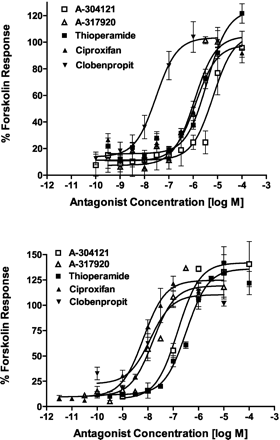This product is for research use only, not for human use. We do not sell to patients.

| Size | Price |
|---|---|
| 250mg | Get quote |
| 500mg | Get quote |
| 1g | Get quote |
Cat #: V3092 CAS #: 360551-59-3 Purity ≥ 98%
Description: A-317920, a piperazine amide, is an inverse agonist radioligand for the H3R receptor. A-317920 potently antagonize native H3Rs by blocking histamine inhibition of potassium-evoked [3H]histamine release from rat brain cortical synaptosomes (pKb values = 8.6 and 9.3) and (R)-alpha-MeHA reversal of electric field-stimulated guinea pig ileum contractions (pA2 values = 7.1 and 8.3). A-317920 is also more efficacious inverse agonists in reversing basal guanosine 5'-O-(3-[35S]thio)triphosphate ([35S]GTP gamma S) binding at the human H3R (pEC50 values = 5.7 and 7.0) than are the imidazole antagonists. These novel and selective piperazine amides represent useful leads for the development of H3R antagonist therapeutic agents.
Publications Citing InvivoChem Products
Product Promise

- Physicochemical and Storage Information
- Protocol
- Related Biological Data
- Stock Solution Preparation
- Quality Control Documentation
| Molecular Weight (MW) | 453.54 |
|---|---|
| Molecular Formula | C25H31N3O5 |
| CAS No. | 360551-59-3 |
| Storage | -20℃ for 3 years in powder form |
| -80℃ for 2 years in solvent | |
| Solubility In Vitro | DMSO: 10 mM |
| Water: N/A | |
| Ethanol: N/A | |
| Synonyms | A317920; A 317920 |
| Protocol | In Vitro | In vitro activity: Kinase Assay: Cell Assay: |
|---|
| Solvent volume to be added | Mass (the weight of a compound) | |||
|---|---|---|---|---|
| Mother liquor concentration | 1mg | 5mg | 10mg | 20mg |
| 1mM | 2.2049 mL | 11.0244 mL | 22.0488 mL | 44.0975 mL |
| 5mM | 0.4410 mL | 2.2049 mL | 4.4098 mL | 8.8195 mL |
| 10mM | 0.2205 mL | 1.1024 mL | 2.2049 mL | 4.4098 mL |
| 20mM | 0.1102 mL | 0.5512 mL | 1.1024 mL | 2.2049 mL |
This equation is commonly abbreviated as: C1 V1 = C2 V2
- (1) Please be sure that the solution is clear before the addition of next solvent. Dissolution methods like vortex, ultrasound or warming and heat may be used to aid dissolving.
- (2) Be sure to add the solvent(s) in order.






































![A-304121 and A-317920 block histamine reversal of potassium-stimulated [3H]histamine release in a concentration-dependent manner in rat brain cortical synaptosomes. J Pharmacol Exp Ther. 2003 Jun;305(3):887-96.](https://invivochem.net/wp-content/uploads/2023/05/CgAH5121WDmAWTtGAABzVgPRNOc514.gif)
![A-304121 and A-317920 decrease basal [35S]GTPγS binding in a concentration-dependent manner in membranes from HEK cells stably expressing the full-length human histamine H3LR. J Pharmacol Exp Ther. 2003 Jun;305(3):887-96.](https://invivochem.net/wp-content/uploads/2023/05/CgAH5121WEWAZ6DHAABlom_LcHk336.gif)